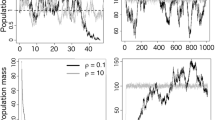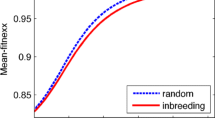Abstract
Populational extinction due to inbreeding depression is analyzed with simple population genetic and population ecological models. Two alternative genetic mechanisms of inbreeding depression, i.e. recessive deleterious genes and overdominant genes, are assumed in separate analyses in order to examine their relative importance. With both mechanisms the population size and the coefficient of inbreeding are maintained at stable equilibria if there is no non-genetic demographic disturbance or stress. With a certain amount of demographic disturbance the population declines rapidly due to interaction between the decrease of population size and the increase of inbreeding coefficient. Such rapid extinction occurs with both genetic mechanisms. However, in the case of overdominant genes extinction happens only if the equilibrium population size is small and the selection coefficient is large such that segregation load is large. In nature, extinction due to overdominant genes is considered to be much less likely than extinction due to recessive deleterious genes.
Similar content being viewed by others
Reference
Barrett, S. C. H. and D. Charlesworth (1991) Effects of a change in the level of inbreeding on the genetic load.Nature 352: 522–524.
Bulmer, M. (1994)Theoretical evolutionary ecology. Sinauer, Sunderland.
Charlesworth, D. and B. Charlesworth (1987) Inbreeding depression and its evolutionary consequences.Annual Review of Ecology and Systematics 18: 237–268.
Crow, J. F. and M. Kimura (1970)An introduction to population genetics theory. Harper & Row, New York.
Frankel, O. H. and M. E. Soule (1981)Conservation and evolution. Cambridge University Press, Cambridge.
Gilpin, M. E. and M. E. Soule (1986) Minimum viable populations: the processes of species extinction. pp. 13–34.In M. E. Soule (ed.)Conservation biology: the science of scarcity and diversity. Sinauer Associates, Sunderland, Mass.
Iwasa, Y. (1990)Introduction to mathematical biology. HBJ, Tokyo (in Japanese).
Mitton, J. B. and M. C. Grant (1984) Associations among protein heterozygosity, growth rate, and developmental homeostasis.Annual Review of Ecology and Systematics 15: 479–499.
Mitton, J. B. (1993) Theory and data pertinent to the relationship between heterozygosity and fitness, pp. 17–41.In N. W. Thornhill (ed.)The natural history of inbreeding and outbreeding. The University of Chicago Press, Chicago.
Mukai, T. (1978)Population genetics. Kodansha Scientific, Tokyo (in Japanese).
Nei, M. (1987)Molecular evolutionary genetics. Cambridge University Press, Cambridge.
Roughgarden, J. (1979)Theory of population genetics and evolutionary ecology: an introduction. Macmillan, New York.
Simmons, M. and J. F. Crow (1977) Mutations affecting fitness inDrosophila populations.Annual Review of Genetics 11: 49–78.
Tanaka, Y. (1997) Extinction of populations due to inbreeding depression with demographic disturbances.Researches on Population Ecology 39: 57–66.
Author information
Authors and Affiliations
Corresponding author
Rights and permissions
About this article
Cite this article
Tanaka, Y. Theoretical aspects of extinction by inbreeding depression. Res Popul Ecol 40, 279–286 (1998). https://doi.org/10.1007/BF02763459
Received:
Accepted:
Issue Date:
DOI: https://doi.org/10.1007/BF02763459




